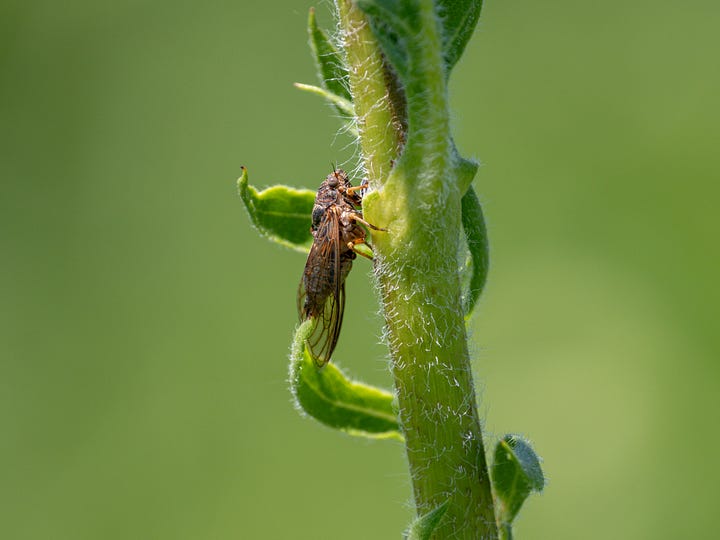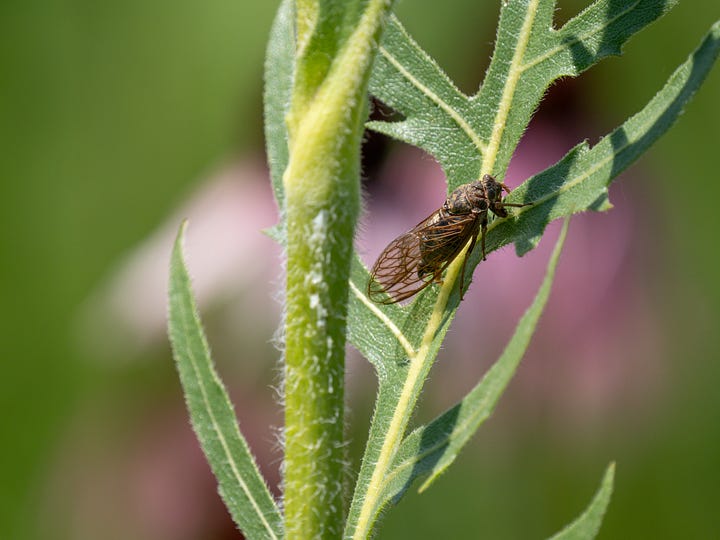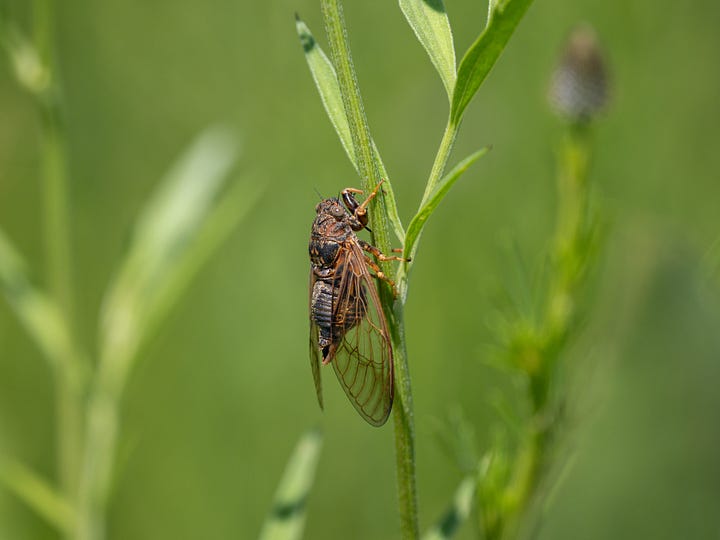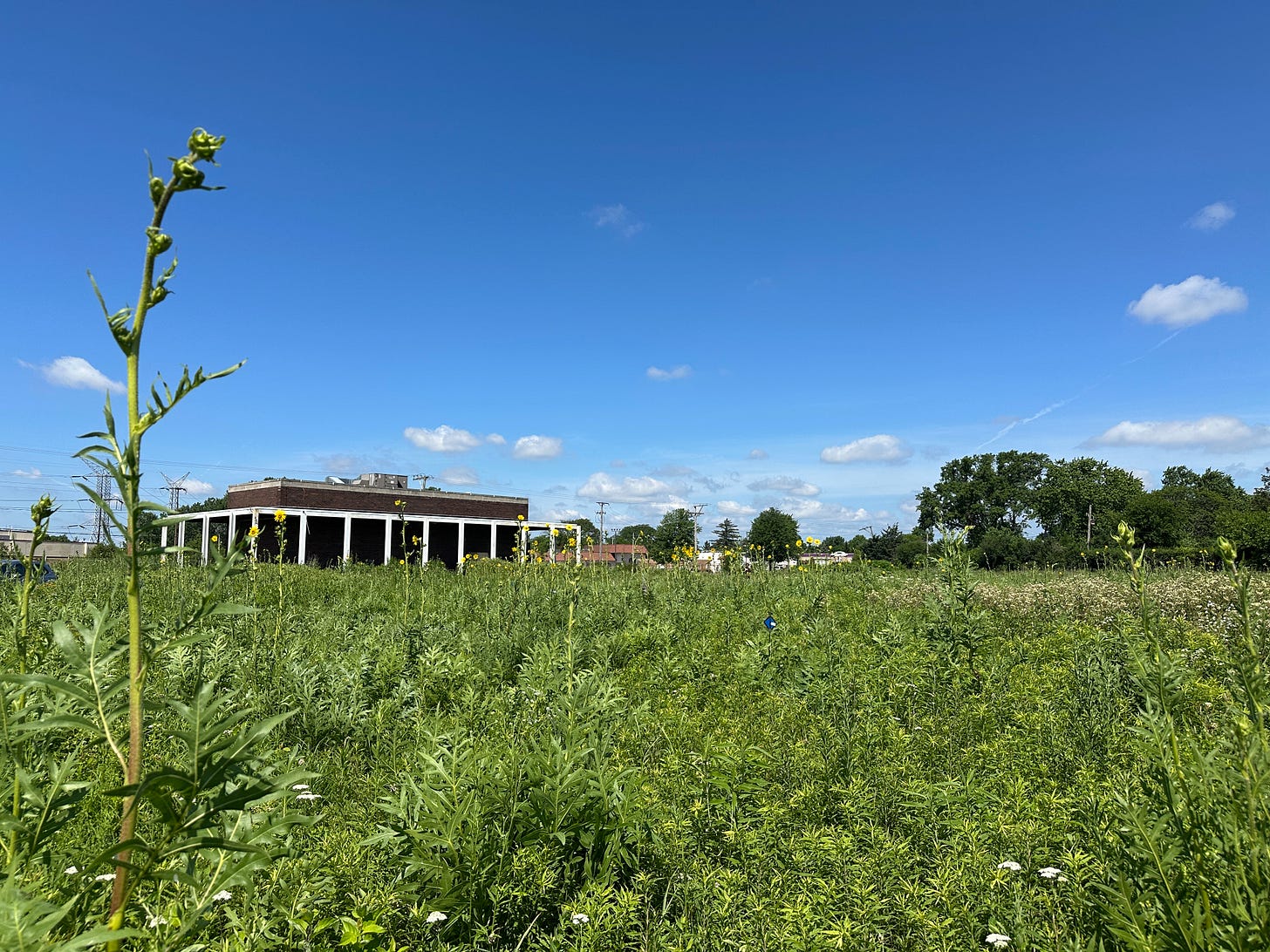There's a time machine in my hometown
Though surrounded by suburbia, it offers a glimpse of what Chicago once was
Disclaimer: This post is not about birds but is about a very cool and very rare cicada!
When I was a kid, growing up in suburban Chicago in the 1980s, my mom would take my brother and me to McDonald’s on a not-so-infrequent basis. Happy Meals had just been launched a few years earlier, and my brother and I loved little prizes that came in each cardboard box almost as much as we loved McDonald’s french fries. The particular Mickey D’s we visited most often was on Milwaukee Avenue, right on the border of Glenview and Niles. It was close to our home and school, and a convenient stop to make after a Little League game, AYSO soccer practice, or a day spent at the public pool. While I can no longer recall any of those once-coveted Happy Meal prizes, I do remember staring out the window of my mom's minivan while we waited in the drive-through, wondering what was going on in the mysteriously empty lot next door.
This particular lot was unusual for the area—instead of containing a strip mall or suburban frame houses, it contained one single story brick building surrounded by a field. The entire space was enclosed by a chain-linked fence and the only entrance, off of Milwaukee Ave., was always locked. I don’t remember ever seeing anyone inside the fence, despite waiting in that particular McDonald’s drive-through many times over many years. It was a mystery, but one that faded from my mind quickly once we moved away from Glenview. Little did I know I’d be back a few decades later, and this time not for McDonald’s french fries.
Though I spend most of my time here rhapsodizing about the perfect magical creatures that we call birds, what I rarely mention is that I fell in love with birds by first falling in love with butterflies and native plants. Pretty soon after I had a tiny yard to call my own, I started converting its grass lawn and beds of hostas and day lilies into beds of native flowers, grasses, and sedges. I’d been evangelized by Douglas Tallamy’s “Bringing Nature Home” and loved leafing through William Cullina’s “Wildflowers: A Guide to Propagating Native Flowers of North America.” When I really wanted to geek out, I’d flip through Joel Greenberg’s massive tome “A Natural History of the Chicago Region” to learn about what this region once was. And that’s where the mystery of that empty lot next to McDonald’s was finally solved. In Chapter 3, Greenberg describes the depressing transformation of Chicagoland prairies and the few remnants that remain. Here’s his description of one:
Because it is small, rich, and surrounded by development, Woodworth is a site that epitomizes the term “prairie remnant.” Houses abut it on the north side and a McDonald’s on the south. A Burger King and Arby’s are across the street: where prairie meets the fast food restaurant.
That was it—the mystery lot! It was the James Woodworth Prairie Preserve! Far from being empty, the lot contains 5 of the only 2300 acres of high-quality prairie remaining in this once Prairie State.
And fortunately, even though I never saw anyone inside the fence when I was a kid, the Woodworth Preserve is open to the public, albeit on a limited basis. Between May 15th - September 15 on Saturdays from 10am-2pm, you can visit this little gem in the heart of suburbia. Step inside, and you step into a time machine—one that gives you a glimpse of what Chicago once was, which is both awe inspiring and heartbreaking. In the spring you can find the blooms of Pink Lady Slipper Orchids, Prairie Lily and Turk’s Cap Lily, followed in the summer by Compass Plant, Prairie Dock, Purple Prairie Clover, and Rattlesnake Master (just to name a few).
Each step brings you into contact with dozens of different species of plants, and who knows how many insects. It’s breadth of biodiversity is startling.
Soon after I learned about the Woodworth Prairie Preserve, I learned about one of its rarest inhabitants, the Prairie Cicada (Okananga balli). This tiny cicada is a prairie-obligate species and only found in remnant prairies in a few locations in Illinois and Wisconsin and some other states. They emerge annually in June and July and sing in late morning through mid-day. I’d tried to find them during a visit a couple years ago but was unsuccessful—perhaps it was too early in the season or perhaps it was because it was a gloomy rainy day. But I planned to try again this weekend, and had higher hopes for my chances. This cicada prefers hot sunny weather and conditions were perfect on both counts.
We arrived Saturday shortly after the gates opened at 10 am and started our search. While I initially thought I heard a cicada just off of the parking lot, it was only a brief snatch of song and not repeated. I wandered off, my attention quickly stolen by all the lovely blooms, including a lone Prairie Lily (Lilium philadelphicum andinum).
As the minutes ticked by though I started to worry. Did we miss them again? Or are they no longer hanging on at this site? Fear of missing out started mixing with a dose ecological grief. I checked the Preserve’s website again to read their recommendations for finding the cicadas:
High temperature increases the probability of hearing the cicada ✅
Sunny days increases the probability of hearing the cicada ✅
Midday (11:30 -2) is the best time of day
Okay, maybe it was just a bit too early in the day yet.
My friends and I split up to cover more ground, and soon Jeff signaled that he heard a cicada. We made our way over to the indicated spot but the song had stopped before we reached it. We split up again, and the cycle repeated—Jeff heard cicada song in another area, but the cicada stopped singing by the time we reached him. This time though I decided to remain where I was. I waited, listening and looking all around. Within just a few minutes one sang from just feet away.
YESSSS!
We couldn’t actually see the cicada, but then another sang not far off. We split up again, this time following our ears as we heard singing cicadas in different parts of the prairie. Soon, they were singing for longer stretches of time, which meant they got a whole lot easier to find. I found my first perched on the thin stem of an unknown-to-me flower.
Then there was one the leaf of a Compass Plant. And then there was another! And another! They were all around, singing away, making babies, and generally living life. The Prairie Cicadas were still here, still hanging on in this tiny and ancient Chicago prairie.




While we found the cicadas on several different types of plants, they seemed to have a particular affinity for Compass Plants. I even found once singing across the fence, in a dense clump of Compass Plants that had popped up between the prairie and Greenwood Avenue. I read this morning that Prairie Cicadas are likely tied to Compass Plants and Prairie Dock, relatives in the Silphium genus. Both have extremely long root systems and young cicadas munch on their roots while living their first several years underground.
Here’s a little snippet of the Prairie Cicada song, which gives us a peak into what the prairies once sounded like. I hope you enjoy it as much as I did!
Thank you so much for reading this not-so-birdy nature story! I’m curious—have you ever heard of this cicada before? Do you love cicadas too, or do they creep you out? Tell me all about it in the comments.










Once again, Sitting here happily stunned. I grew up on the south side and played far more games on cement than grass in my early years. I knew the real world was around but never seemed to get too involved with it.
Your story was damn close to exciting, essentially happening in a Mickey D parking lot at that!
I don't have either an affinity or an aversion to cicadas, but none of the ones I've ever encountered sounded so birdlike!
Thanks for this special field report.
As a kid in Texas, I used to find the shed skins of cicadas clinging to tree trunks. I thought they were fascinating, with the split up their backs through which the bug had departed.